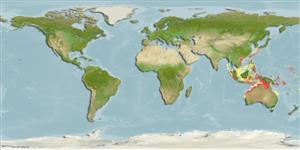>
Gobiiformes (Gobies) >
Gobiidae (Gobies) > Gobiinae
Etymology: Lobulogobius: Latin, lobulus = lobe + Latin, gobius = gudgeon (Ref. 45335); morrigu: Morrigu: the old Irish war goddess, in reference to the jaws and dentition (Ref. 11432).
Eponymy: Morrigu, or The Morrigan (thought to mean ‘Phantom Queen’), is a war goddess in old Irish mythology. The name was given “in reference to the jaws and dentition” of this goby, which has several rows of sharp, pointed teeth. (Ref. 128868), visit book page.
More on author: Larson.
Environment: milieu / climate zone / depth range / distribution range
Ecologia
marinhas demersal; intervalo de profundidade 28 - 72 m (Ref. 11432). Tropical
Western Central Pacific: Arafura Sea.
Tamanho / Peso / Idade
Maturity: Lm ? range ? - ? cm
Max length : 3.1 cm SL macho/indeterminado; (Ref. 11432)
Descrição breve
Chaves de identificação | Morfologia | Morfometria
Espinhos dorsais (total) : 7; Raios dorsais moles (total) : 8; Espinhos anais: 1; Raios anais moles: 9. Compressed head and body, and rather small eyes and sculpturing on the angle of the preopercle. Pelvic fins fused to form rounded cup, and frenum folded forming an anteriorly-facing pocket. Head and nape without scales. Eyes set laterally and high on head. Interorbital wide, about twice eye diameter. Mouth anterior and oblique, with several rows of curved pointed teeth. Tongue blunt or bilobed. Gill opening wide, gill membranes free of isthmus and each other until they meet as isthmus at a point below the eye. Unpaired fins low. Pectoral rays 19, branched in adults (Ref. 11432).
Commensal in sponges and gorgonians (Ref. 11432, 48637).Commensal with sea pens and hollow, banching gorgonians (genus Solenocaulon) (Ref 90102).
Life cycle and mating behavior
Maturidade | Reprodução | Desova | Ovos | Fecundidade | Larvas
Larson, H.K. and E.O. Murdy, 2001. Gobiidae. Gobies. p. 3578-3603. In K.E. Carpenter and V. Niem (eds.) FAO species identification guide for fishery purposes. The living marine resources of the Western Central Pacific. Vol. 6. Bony fishes part 4 (Labridae to Latimeriidae), estuarine crocodiles. FAO, Rome. (Ref. 42915)
Categoria na Lista Vermelha da IUCN (Ref. 130435: Version 2024-1)
Ameaça para o homem
Harmless
Utilização humana
Ferramentas
Relatórios especiais
Descarregue XML
Fontes da internet
Estimates based on models
Preferred temperature (Ref.
123201): 24.7 - 28.3, mean 27.4 °C (based on 110 cells).
Phylogenetic diversity index (Ref.
82804): PD
50 = 0.6250 [Uniqueness, from 0.5 = low to 2.0 = high].
Bayesian length-weight: a=0.00724 (0.00339 - 0.01546), b=3.10 (2.92 - 3.28), in cm total length, based on LWR estimates for this (Sub)family-body shape (Ref.
93245).
Nível Trófico (Ref.
69278): 3.1 ±0.3 se; based on size and trophs of closest relatives
Resiliência (Ref.
120179): Elevada, tempo mínimo de duplicação da população menor que 15 meses (Preliminary K or Fecundity.).
Fishing Vulnerability (Ref.
59153): Low vulnerability (10 of 100).
